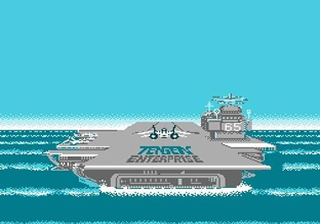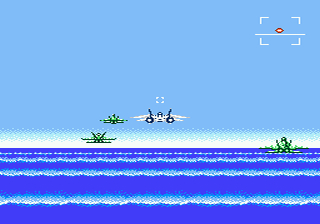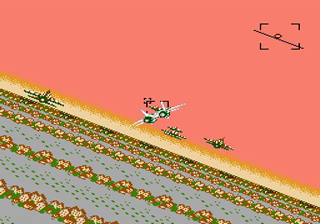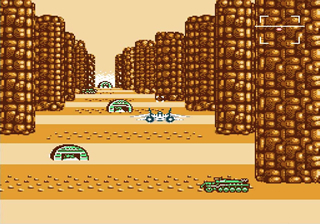Genre: Shmup Developer: Tengen Publisher: Tengen Players: 1 Released: 1989
Sega released After Burner in the arcades in 1987, and it was one of the year’s biggest hits (as far as arcades go), with its tilting cockpit and screen and the jamming surround sound speakers. It had some of the best visuals and features ever seen in an arcade at the time, and everyone wanted a piece of it. It only seemed natural for someone to pick the rights up for the home console ports. Sega seemed to have licensed the rights out to everyone under the sun at the time, as a multitude of publishers released the game for several different consoles, some being good and some being bad. I was able to sit down and spend some time with Tengen’s port to the NES armed with my trusty Game Genie and put it through the paces. This port of the game seems to get little to no attention anymore and I didn’t know much about it before playing it but my outlook on this game has remained largely positive so lets take a deeper look at AfterBurner for the NES.
You may be wondering just how well a port of such an advanced and complicated arcade game could possibly work so early on in the Nintendo Entertainment System’s life span, but it still holds up fairly decent. Tengen did a respectable job converting the game, and I’d even venture off to say that it is one of its stronger offerings for the NES console. Sure, it isn’t Pac-Mania or Tetris, but it still remains very playable if you’re willing to overcome the learning curve and give it some time.
The biggest thing that After Burner has working against it right from the get-go is its brutal difficulty. When you first turn the game on, you’re treated to a pretty basic title screen where you’re simply only able to press start and play the game without any kind of way to change the difficulty at all. When I first started the game I was barely able to get to the second level. Once I got better I could get to maybe the third or fourth level at best (there are 22 levels total), so that should tell you what kind of mettle you have to have if you attempt to play this game.
The actual gameplay itself is very easy to pick up right from the start. Up and down are inverted, just as they should be. The A button fires your Vulcan cannon or gun, and B is your missiles. Pressing start uses the afterburner for a burst of speed which ends up being pretty useless, at best. The select button is your pause in this game.
Once I realized that I didn’t stand a chance of getting far enough in After Burner for a review, I used an infinite lives code with the Game Genie. As I played all the way through I realized just how much effort Tengen put into this port, as every stage from the arcade is present here as far as I can tell. The stages where you attach to the plane to reload are here, as are the stages where you reload on the ground with the vehicles; even the bonus stages where you fly between the pylons are also present. I was actually pretty impressed and disappointed by the end of the game, impressed because Tengen put so much effort into this when it didn’t usually put much effort into many of its games at the time. I was disappointed because the ending was simply a screen that said “Congratulations,” after all that hard work. The game also got pretty tedious by the last several stages as the gameplay didn’t change up very much at all, and most of the stages were mere background changes and nothing more.
After Burner is also a victim of being on underpowered hardware. The screen still rotates when you move from side to side, but the hardware simply can’t keep up and the frame rate, and scrolling become very choppy. It’s nothing that you aren’t able to learn to work with with some practice, but it still makes the game frustrating because the enemy fire becomes very hard to see until it’s too close to you and you take a hit.
Thankfully, all of the audio made the jump to the lesser hardware almost completely intact. Each musical track from the arcade has made it to the NES, but even with the limited audio they all sound rather flat and mundane. They could all use a few more layers and richer sound, but at least you get to listen to that classic After Burner tune that we’ve all come to like. The sound effects sound a lot nicer than the music and are very easy to listen to, and this helps keep the game from becoming grating on the ears.
After Burner has plenty of flaws and isn’t going to make it on anyone’s top lists for the NES, but Tengen did a respectable job on this port. It’s also worth mentioning that this game plays better than either Top Gun offering and F-15 Strike Eagle as well, so fans of the genre or of nostalgia in general will find it worth spending at least a little while with it. Give it a try because you have nothing to lose.






its amazing how good this port is, considering the nes shinobi and alien syndrome are pretty bad.